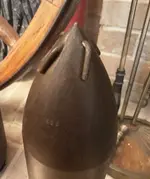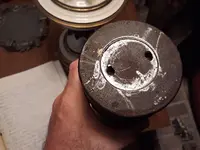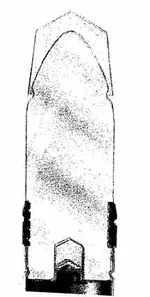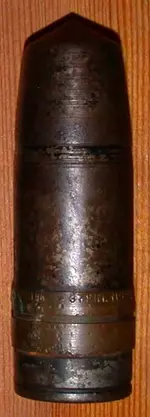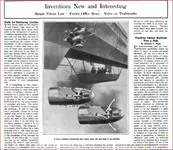OK, guessing again...
Any chance there was something like a nose cone attached by the wires?
[FONT="]APC projectile: schematic (left) and 37mm M59 projectile {WW2}[/FONT]
No, not a chance of that. Totally smooth. Thanks though for breaking my block about what this is used for. I had only seen small balloon shot and didn't think large was ever thought of.
However, I've given a lot of thought to your anti balloon idea. It seemed impossible, because it is such a large projectile, but upon reflection does have some good arguments for it.
It's an experimental shell. If you were sitting at your desk, designing something to shoot a balloon down, what ideas could you come up with to deal with the problems associated with that task? What would you know about shooting down a balloon over open water. (naval)
A balloon could sight ships from a long distance or very high altitude. The range on that gun would be far and the farther reach might be able to bring it down. Lets go with something with gas.
Once a shell gets to the extremity of its range its velocity will be lower and unless a direct hit is made a conical shell will likely glance off. If a direct hit is made it may just put some neat holes in the balloon. The target will keep on going or just descend back to the earth in whatever fashion it could taking its information back down with it.
What if we put some heavy gauge wires at 45^ angles on the cone? If it reaches the target at low velocity it will penetrate and rip a larger hole in the canvas. Perhaps it will wrap a large section into it. If it makes it through perhaps it will be slowed enough to do most of its damage on the opposite side dragging though it and making a large rip.
Its a pretty decent theory that describes that shell and fits with its condition.
The shell has been fired, yet it is completely undamaged. The cone and the body don't have a scratch. If it went into a balloon at long range and got wrapped up in it that would be the case. Perhaps this is the one that worked and the inventor kept it as a memento. More likely this one did not work though as the wires are flattened against the cone. It seems that it never became any sort of approved ordinance. I imagine in the end the theoretical shell did just as well as what they already had so they never used it.
This seems to be a possibility. When I think naval shells of that day I tend to think only in terms of steel monsters slugging it out. This was perhaps a tentative step into the new realities.
Still can't get that plug out.
